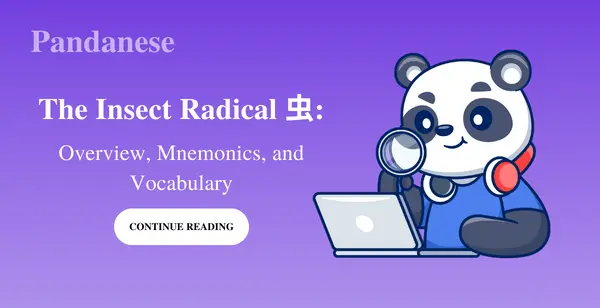
The Insect Radical 虫: Overview, Mnemonics and Vocabulary
Welcome to our Pandanese radical series!
For those who are out of the loop, Chinese radicals are very important and useful for every Chinese learner. It’s because Chinese radicals often give you a hint of what the character means or how it sounds.
In today’s article, we’ll introduce you to the insect radical, what it is, how to memorize it, and the vocabulary related to the insect radical.
What is the insect radical?

In Chinese, the radical for insect is pronounced as “chóng” and written as 虫. This radical is composed of 6 strokes and is listed as radical 142 according to the Kangxi radical chart (a system of radicals of Chinese characters).
The radical 虫 models a worm or insect. However, characters of creeping animals such as reptiles, amphibians, and shellfish all include this radical as a prefix. For example:
蜥 蜴 xīyì (lizard)
蛙 wā (frog)
蚝 háo (oyster)
Some Chinese learners argue that this radical 虫 chóng is nothing like a worm or insect while other radicals such as 一 yī (one), 亅 jué (hook), or 口 kǒu (mouth) are good examples of how the character and the object they describe are well related. This is because 虫 was originally a pictograph of a poisonous snake. This was observed in the Oracle Bone, Bronze, and Traditional forms of the character, where a wide flat structure resembles a cobra’s hood.

Historical forms of the character 虫
In ancient times, 虫 meant a poisonous snake and its derivative character 蟲 meant worm or insect. However, 虫 evolved to mean insects and worms. Therefore, a new character shé 蛇 with the insect radical was created to mean “snake.”
What is the stroke order of the radical 虫?
The insect radical has six strokes, written in the following stroke order:

Insect radical 虫 stroke order
How can you memorize the insect radical?
As mentioned above, this radical 虫 doesn’t evoke the image of any insect or worm. Therefore, it could cause us trouble if we’re trying to pin it into our memory.
Pandanese created this mnemonic for you to remember the meaning: Some insects have big googly eyes and skinny bodies like this radical.
Additionally, Pandanese has this mnemonics to remember the writing and meaning: Why is the inside of your mouth (口) lined (丨) with insects (虫)?
If you want to learn Chinese characters better, do it with Pandaese! They employ mnemonics with the SRS to help Chinese learners get the most out of their learning. The first three levels are free, so try it out!
Insect radical vocabulary list for you
Want to know more about the insect radical and other related terms? Let’s learn some words that have this radical.
Character |
Pinyin |
English meaning |
蚕 |
cán |
silkworm |
苍蝇 |
cāng ying |
fly |
蚊子 |
wén zi |
mosquito |
蜜蜂 |
mì fēng |
bee |
甲虫 |
jiǎ chóng |
beetle |
毛虫 |
máo chóng |
caterpillar |
蚂蚁 |
mǎ yǐ |
ant |
蝴蝶 |
hú dié |
butterfly |
蜻蜓 |
qīng tíng |
dragonfly |
蚱蜢 |
zhà měng |
grasshopper |
蝗虫 |
huáng chóng |
locust |
螳螂 |
táng láng |
mantis |
萤火虫 |
yíng huǒ chóng |
firefly |
蜗牛 |
wō niú |
snail |
蚯蚓 |
qiū jǐn |
earthworm |
In closing
Chinese radicals are the building blocks for learning Chinese words. So learning the insect radical 虫 will give some insight into Chinese vocabulary that is related to words related to insects, worms, and even reptiles.
Keep learning Chinese radicals to build up your Chinese vocabulary.
The easiest way to learn Chinese & build vocabulary

